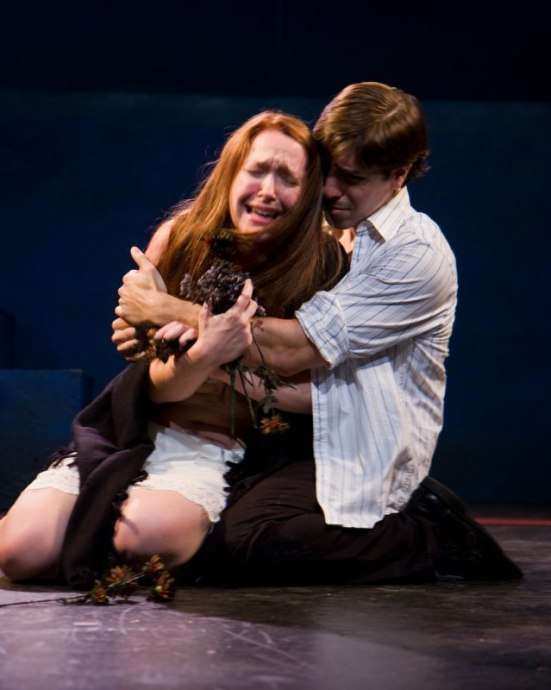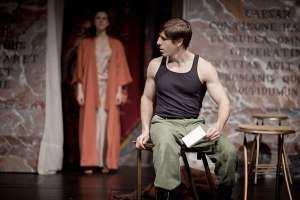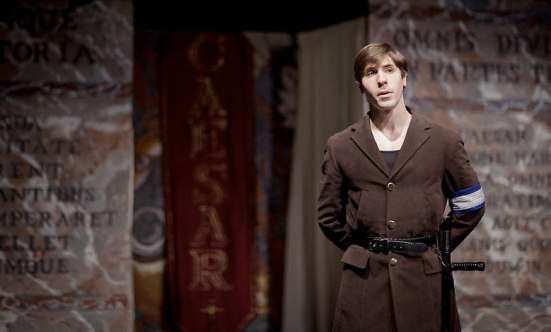NEW YORK CITY — In between scenes while performing Laertes in the Gallery Players’s production of Hamlet in Brooklyn, the young classical actor Dan Lawrence juices up his body to achieve what he calls “a rasic performance.”

Dan Lawrence in "Hamlet" by Gallery Players (Brooklyn, NY) | Photo courtesy of Thomas George and Gallery Players.
“Laertes appears early on in Shakespeare’s play and then he disappears, but when he re-enters the play, basically he is already in a high emotional state,” the 26-year-old Lawrence recalls in an interview near Times Square‘s Broadway district. “Laertes bursts into the kingdom, and he’s ready to kill. He suspects the king for Ophelia’s murder. Everything that happens, after he reappears, happens very quickly — it’s all discoveries, one thing after another. The part requires many different emotional qualities and aspects of awareness, so I definitely used rasabox training for that. While I’m off-stage for an hour, I can go through my script as much as I want, but the real question is, How am I going to enter that emotional state physically?”
About 20 minutes before his reappearance, Lawrence decides to cook up breath, sound and movement so that he can taste the complex flavors of rasa when portraying a mightily pissed-off Laertes. “Before I entered the stage,“ Lawrence recalls, “I started with the gestures. I brought in breath — and the sounds, when I could. Obviously I wasn’t shouting off stage, but I was preparing myself physically so that when I burst onto the stage, I was already there mentally. For me rasabox training is always a fail-safe system when I’m in scene but am not getting there mentally, or something is wrong and I am not connecting. I have this physical way to jump-start my emotions. I can start with a physicalization of those emotions, and rasabox will take me into that state. This is a real way to develop the body and practice it like an instrument. Rasaboxes is a way to develop the music of emotions.”
According to rasaboxes performer training, a physical theatre system developed by the theorist/director Richard Schechner in the late 1990s — which was in turn interculturally drawn from a manual of ancient Sanskrit performance theory called Natyasastra — human beings experience nine flavors of rasa (or feeling), which correspond to nine types of sthayi bhava (or emotion). The rasa called raudra, for example, links up to the sthayi bhava called krodha, which means anger or rage. Other rasas correspond to desire/love, humor/laughter, pity/grief, energy/vigor, fear/shame, disgust, surprise/wonder and bliss.
“Every emotion is a sthayi bhava,” writes Schechner in his theoretical précis “Rasaesthetics,” which blends the Natyasastra’s performance theory with contemporary emotion research, neuroscience and Antonin Artaud’s Western call for “an athlete of emotions.” “The sthayi bhavas are the ‘permanent’ or ‘abiding’ or indwelling emotions that are accessed and evoked by good acting. Acting is the art of presenting the sthayi bhavas so that both the performer and the partaker [i.e., the audience] can ‘taste’ the rasa.”
In terms of training, Schechner and his East Coast Artists colleagues Michelle Minnick and Paula Murray Cole have developed a series of exercises that follow an orderly progression. The exercises combine breath, sound and movement with nine of the Sanskrit rasas, or “flavors” of feeling, creating a step-by-step system that helps actors like Lawrence safely and effectively explore a wide range of emotions.

"Hamlet" by Gallery Players (Brooklyn, NY) | Photo courtesy of Thomas George and Gallery Players.
“Rasaboxes exercises start step by step and continue to be more involved,” Lawrence states. “First the idea of rasa, which is basically a tasting of emotions, is introduced. These Sanskrit words are core emotions, very archetypal basics, and what happens then is that we make a diagram on the floor of these emotions and we write the words in those boxes. Once were familiar with what these terms mean, we write out our own definitions of these boxes: how we identify with these emotions. For example, you draw something that connects with ‘fear,’ or you come up with other words that make you fearful. You’re developing a personal relationship with these emotions.”
The next step is entering the boxes, but the process of entering them becomes very involved. “When you enter the box you create a gesture or a pose,” Lawrence says. “Initially you stay in the box for no longer than a minute. You start with a pose and experience it for a couple of seconds, you see what that feels like, and you jump out of the box and go to neutral. But, you see, a pose has a negative connotation in all movement techniques, because a pose is viewed as being very artificial. Rasabox exercises help you move from these gestures of core emotions that are often clichés, and the idea is to go past them. When you leap into an emotion an actor, you become an athlete, in a way, who jumps into a field and intensely experiences the game, and then you come off the field to stand in the sidelines.”
Interested in seeing the rasa emotions in action? Watch Dan Lawrence perform rasa improv on YouTube.com:
Learning the gestures associated with the rasa boxes is just the beginning, however. In introducing the breath into the pose, the actor begins to learn that each box has a different breath associated to it. After breath comes sound and then still later movement. “Once you combine all those things, it is hard not to move if you have the sound in place,” Lawrence says. “Once you go into the boxes and you have the gesture and breath, emotions begins to happen, and memories start to happen. Stories begin to develop in your head. Eventually you bring in the monologues, texts, and scenes. That’s the best part, because you’re experiencing rasas with other actors. You’re layering. You’re tasting rasas with somebody else onstage. The scene is the groundwork and the rasa is the layering. The script is the piece of music. And the rasa is the annotation you’re going to make: the tempo, the quality of brightness or softness, all the sensations — it’s the recipe.”
One advantage of the rasabox method is that it allows an actor the freedom to improvise, as if leaping into a cold pool of water. “You’re defeating your rationality and critical thinking right away,” Lawrence says. “You’re getting into your area of vulnerability a lot faster. It‘s about spontaneity and training yourself not to pre-plan things.”

Dan Lawrence in "Julius Caesar" at The Shakespeare Theatre of NJ | Photo by Laura Steffen Sterling.
Moreover, the lengthier an actor’s involvement has been with each rasabox, the richer the flavors when emotions are shared with other actors in the room. “How do you experience despair and happiness at the same time, for instance, like crying through tears of joy?” Lawrence says. “Layering means layering emotions. The whole idea is that we already have the ingredients in our body for these things, and there is a way to cook them, a formula, to bring about the emotions. It’s definitely an external process, and it moves inward. You start with physicality, the breath, the sound. And memory starts to happen of experiences you’ve had. The body remembers how it feels like. Your imagination starts to happen, and you create a scenario for what is going on..”
Having cut his teeth professionally at Hudson Valley Shakespeare Festival in Garrison, New York, and Shakespeare Theatre Company in Washington, D.C., Lawrence was tutored by Paula Murray Cole, a theatre professor at Ithaca College and one of the many Schechner disciples who are certified to teach this training method to both acting and musical theatre majors. Rasaboxes has also been taught by Michele Minnick, Rachel Bowditch, Fernando Calzadilla and Marcia Moraes in annual summer workshops offered through the Department of Performance Studies at New York University. Introductory and intensive rasaboxes workshops have been offered at the Actor‘s Movement Studio since 2005, as well as the Dell’ Arte International School of Physical Theatre, University of Tennessee at Knoxville, and Central Washington University, in Ellensburg, Wash.
For Lawrence, rasabox training has been “such an eye opener.” “For a long time the techniques I had been using were too intellectual and too cerebral. This training starts from a very physical approach. It got me out of habits of physicality that I was used to as an actor. It opened up my physical range and my vocal range. It really gave me a chance to experiment with things that I did not feel safe to do before.”
Even more important than as a form of actor training, Lawrence says rasabox training can be applied to performance composition. “I am preparing right now to play Brutus in Julius Caesar for the Shakespeare Theatre of New Jersey. Already I’m annotating my scripts with rasas of where I’m going to be: finding what emotional states and qualities of gestures. I use rasabox to go through the text emotionally. I got to use it when I performed Oedipus and as Antony in Antony and Cleopatra.”
With a strong following among drama therapists and in the corporate world, Rasabox training is still on the verge of being embraced as an tool to train an actor’s emotions to be ready and available. “But the ultimate goal is to have it work on stage,” Lawrence says. “My interest was always how can I use this and apply it to a role. I came into it with that mentality. I never wanted to be a teacher of it. I always wanted to explore it and maybe build a performance of some sort with it. Rasa is a shared tasting, a connection. It cannot be experienced by itself. It must be experienced with a viewer. The people who practice it are serious advocates of it.” —RG

Dan Lawrence in "Julius Caesar" at The Shakespeare Theatre of NJ | Photo by Laura Steffen Sterling.
Pingback: Other places | Superfluities Redux
this article is very cool
is he tickelish gosh